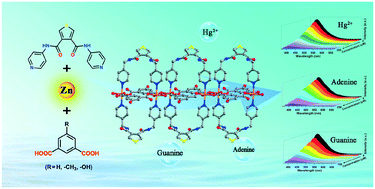Three Zn(ii) coordination polymers constructed with a new amide-thiophene-derived bis-pyridyl ligand as ultrasensitive luminescent sensors for Hg(ii) and purines†
Abstract
The designing and practicality of luminescent coordination polymers (LCPs) as sensors for the detection of molecules and ions constitutes an active area of research. Three new one-dimensional LCPs, [Zn2(4-bpft)2(1,3-BDC)2]·2H2O (LCP 1), [Zn(4-bpft)(5-MIP)] (LCP 2), and [Zn(4-bpft)(5-HIP)] (LCP 3) (4-bpft = N,N′-bis(4-pyridine formamide)-3,4-thiophene; 1,3-H2BDC = isophthalic acid; 5-H2MIP = 5-methylisophthalic acid; H2HIP = 5-hydroxyisophthalic acid), have been successfully synthesized with a new amide-thiophene-derived bis-pyridyl ligand under hydrothermal conditions. The LCPs 1–3 were characterized by single-crystal X-ray diffraction, FT-IR, and powder X-ray diffraction patterns, which show a 1D chain structure. A series of luminescence recognition tests proved that LCPs 1–3 can act as fluorescent sensors for detecting Hg(II) ions and purines in an aqueous environment. Besides, LCPs 1–3 possess good stability and can selectively detect Hg(II), adenine, and guanine in the presence of competing analytes. Consequently, LCPs 1–3 are highly promising candidates for sensing mercury ions, adenine, and guanine in water.

- This article is part of the themed collection: Coordination Networks


 Please wait while we load your content...
Please wait while we load your content...